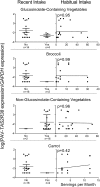Human bitter perception correlates with bitter receptor messenger RNA expression in taste cells
- PMID: 24025627
- PMCID: PMC3778862
- DOI: 10.3945/ajcn.113.066688
Human bitter perception correlates with bitter receptor messenger RNA expression in taste cells
Abstract
Background: Alleles of the receptor gene TAS2R38 are responsible in part for the variation in bitter taste perception of 6-n-propylthiouracil (PROP) and structurally similar compounds (eg, glucosinolates in cruciferous vegetables). At low concentrations, people with the PAV ("taster" amino acid sequence) form of TAS2R38 perceive these bitter compounds, whereas most with the AVI ("nontaster" amino acid sequence) form do not; heterozygotes (PAV/AVI) show the widest range of bitter perception.
Objectives: The objectives were to examine individual differences in expression of PAV-TAS2R38 messenger RNA (mRNA) among heterozygotes, to test the hypotheses that the abundance of allele-specific gene expression accounts for the variation in human bitter taste perception, and to relate to dietary intake of bitter-tasting beverages and foods.
Design: Heterozygous individuals (n = 22) provided psychophysical evaluation of the bitterness of PROP, glucosinolate-containing broccoli juice, non-glucosinolate-containing carrot juice, and several bitter non-TAS2R38 ligands as well as dietary recalls. Fungiform taste papillae were examined for allele-specific TAS2R38 expression by using quantitative polymerase chain reaction.
Results: PAV-TAS2R38 mRNA expression was measured in 18 of 22 heterozygous subjects. Relative expression varied widely and positively correlated with ratings of bitterness intensity of PROP (P = 0.007) and broccoli juice (P = 0.004) but not of the control solutions carrot juice (P = 0.26), NaCl (P = 0.68), caffeine (P = 0.24), or urea (P = 0.47). Expression amounts were related to self-reported recent and habitual caffeine intake (P = 0.060, P = 0.005); vegetable intake was too low to analyze.
Conclusions: We provide evidence that PAV-TAS2R38 expression amount correlates with individual differences in bitter sensory perception and diet. The nature of this correlation calls for additional research on the molecular mechanisms associated with some individual differences in taste perception and food intake. The trial was registered at clinicaltrials.gov as NCT01399944.
Figures





Similar articles
-
Supertasting and PROP bitterness depends on more than the TAS2R38 gene.Chem Senses. 2008 Mar;33(3):255-65. doi: 10.1093/chemse/bjm084. Epub 2008 Jan 21. Chem Senses. 2008. PMID: 18209019
-
Caffeine Bitterness is Related to Daily Caffeine Intake and Bitter Receptor mRNA Abundance in Human Taste Tissue.Perception. 2017 Mar-Apr;46(3-4):245-256. doi: 10.1177/0301006616686098. Epub 2017 Jan 24. Perception. 2017. PMID: 28118781 Free PMC article.
-
Association between Genetic Variation in the TAS2R38 Bitter Taste Receptor and Propylthiouracil Bitter Taste Thresholds among Adults Living in Japan Using the Modified 2AFC Procedure with the Quest Method.Nutrients. 2023 May 22;15(10):2415. doi: 10.3390/nu15102415. Nutrients. 2023. PMID: 37242298 Free PMC article.
-
A meta-analysis on polymorphic trait of taste perception mediated by TAS2R38 genotype.Exp Clin Psychopharmacol. 2024 Oct;32(5):497-505. doi: 10.1037/pha0000728. Epub 2024 May 30. Exp Clin Psychopharmacol. 2024. PMID: 38815112 Review.
-
Genetic sensitivity to the bitter taste of 6-n-propylthiouracil (PROP) and its association with physiological mechanisms controlling body mass index (BMI).Nutrients. 2014 Aug 27;6(9):3363-81. doi: 10.3390/nu6093363. Nutrients. 2014. PMID: 25166026 Free PMC article. Review.
Cited by
-
Relationships of PROP Taste Phenotype, Taste Receptor Genotype, and Oral Nicotine Replacement Use.Nicotine Tob Res. 2015 Sep;17(9):1149-55. doi: 10.1093/ntr/ntu281. Epub 2014 Dec 26. Nicotine Tob Res. 2015. PMID: 25542917 Free PMC article. Clinical Trial.
-
Analysis of seven salad rocket (Eruca sativa) accessions: The relationships between sensory attributes and volatile and non-volatile compounds.Food Chem. 2017 Mar 1;218:181-191. doi: 10.1016/j.foodchem.2016.09.076. Epub 2016 Sep 13. Food Chem. 2017. PMID: 27719896 Free PMC article.
-
Variations in the TAS2R38 gene among college students in Hubei.Hereditas. 2022 Dec 19;159(1):46. doi: 10.1186/s41065-022-00260-x. Hereditas. 2022. PMID: 36529808 Free PMC article.
-
A Comparison of Collection Techniques for Gene Expression Analysis of Human Oral Taste Tissue.PLoS One. 2016 Mar 24;11(3):e0152157. doi: 10.1371/journal.pone.0152157. eCollection 2016. PLoS One. 2016. PMID: 27010324 Free PMC article.
-
Functional Alteration and Differential Expression of the Bitter Taste Receptor T2R38 in Human Paranasal Sinus in Patients with Chronic Rhinosinusitis.Int J Mol Sci. 2023 Feb 24;24(5):4499. doi: 10.3390/ijms24054499. Int J Mol Sci. 2023. PMID: 36901926 Free PMC article.
References
-
- Drewnowski A, Gomez-Carneros C. Bitter taste, phytonutrients, and the consumer: a review. Am J Clin Nutr 2000;72:1424–35 - PubMed
-
- Chandrashekar J, Mueller KL, Hoon MA, Adler E, Feng L, Guo W, Zuker CS, Ryba NJ. T2Rs function as bitter taste receptors. Cell 2000;100:703–11 - PubMed
-
- Adler E, Hoon MA, Mueller KL, Chandrashekar J, Ryba NJP, Zuker CS. A novel family of mammalian taste receptors. Cell 2000;100:693–702 - PubMed
Publication types
MeSH terms
Substances
Associated data
Grants and funding
LinkOut - more resources
Full Text Sources
Other Literature Sources
Medical

